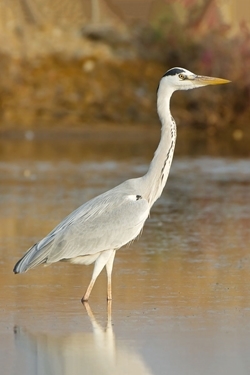Grey heron
 The grey heron (Ardea cinerea) is a beautiful statuesque bird, native to vast swathes of the Eastern Hemisphere. It’s found in a broad range of wetland habitats from Britain to Norway, to Japan, and South Africa and almost every country in between - bar the hottest deserts, and the coldest mountain ranges.
The grey heron (Ardea cinerea) is a beautiful statuesque bird, native to vast swathes of the Eastern Hemisphere. It’s found in a broad range of wetland habitats from Britain to Norway, to Japan, and South Africa and almost every country in between - bar the hottest deserts, and the coldest mountain ranges.
Here in Britain, the grey heron is one of the tallest birds you’ll encounter, standing at over a metre in height. Its size, combined with its smart grey black and white whiskery plumage, makes this fishing specialist instantly recognisable. Despite its grand looks and a 6ft whopper of a wingspan, the average heron weighs little more than a pheasant, with bigger males only reaching a maximum of 2 kilograms.
The grey heron is quite vocal, with a variety of calls depending on behaviour. The most commonly heard is its grating ‘fraarnk’ flight call, and if alarmed it emits a ‘go-go-go’. An ‘oooo’ is used in courtship display (which is somewhat fitting), and they also ‘clap’ at each other with their bills in greeting and in mating displays.
Herons nest in big trees, in groups called heronries. These are often habitual sites that are revisited year after year and may involve dozens of nests, spanning multiple trees. The largest heronry in Britain is currently at Northward Hill in Kent, where numbers of nests are between 150 and 200! Herons start to nest quite early and it’s not unusual to see herons sitting on eggs in early February, but nesting activity peaks in late March.
Herons are most frequently spotted in still-water habitats such as floodplains, ponds and lakes, because swirly, bubbly water makes it a little more challenging to spot prey. They are stealthy ambush hunters, and a prey animal in their sight rarely escapes. To hunt, they pace slowly in the shallows, pausing to observe, and may spend long periods of time stood stock-still waiting for something to come close. When ready to strike, their neck and long sharp bill can be extended in the blink of an eye.
They eat newts, frogs, small reptiles, small mammals and waterbirds and a whole spectrum of fish species from minnows to huge, powerful adult eels. They are not shy of hunting in gardens, as I can personally attest when a heron visited my newly created wildlife pond and, to my dismay, made off with the much-celebrated inaugural newt I had discovered the previous day!
It’s thought that young herons in particular like to learn and practice in garden ponds, where prey is easier to catch. Nets are the only sure-fire way to stop your fish being taken – decoy herons are thought to attract rather than repel them. Like owls, herons regurgitate pellets of fur and bones, and if disturbed (especially on a nest) they will vomit their half-digested meals, so it’s probably best not to stand beneath a heronry and say hello loudly – you might get an unsavoury reply.
On the continent, in the Netherlands especially, herons are reputed to be enjoying an urban lifestyle, visiting street markets and snack bars, offering clean-up services to fish vendors and being fed by friendly gardeners. This happens more so in the winter, which can be a difficult time for herons in some of the colder regions of countries, when amphibians hibernate and fish go down into more insulating depths, and wetlands and ponds may be frozen for prolonged periods.
A fully grown grey heron has few natural predators or threats and the species has adapted reasonably well to a human-dominated world. Once upon a time, though, in Britain at least, it was hunted. Roast herons were a feature of banquets in medieval times. Something so tall, lean and stringy doesn’t seem that appetising, but a 1513 book by a Mr Wynkyn de Worde suggested that you “sauce hym with vynegre, mustarde, poudre of ginger, and salte”, which I’m sure made all the difference!
A slightly later book from 1660 called The Accomplisht Cook by Robert May indicates that young herons were sometimes plucked from nests and kept in sheds to grow on. They were fed “livers, and the entrails of beasts, and such like, cut in great gobbits”. Not all were destined for the pot, though; falconers desired them because they were found to be useful quarry for training hawks. Apparently right here where I live in the Test Valley in the 12th Century, King John would bring hunting parties specifically to fly hawks at cranes and herons. I think the next time I see the resident heron in the River Test meadows I will make sure to remind him how fortunate he is before he takes off!
Jess Brooks
Advisory
Photo credit: JJ Harrison